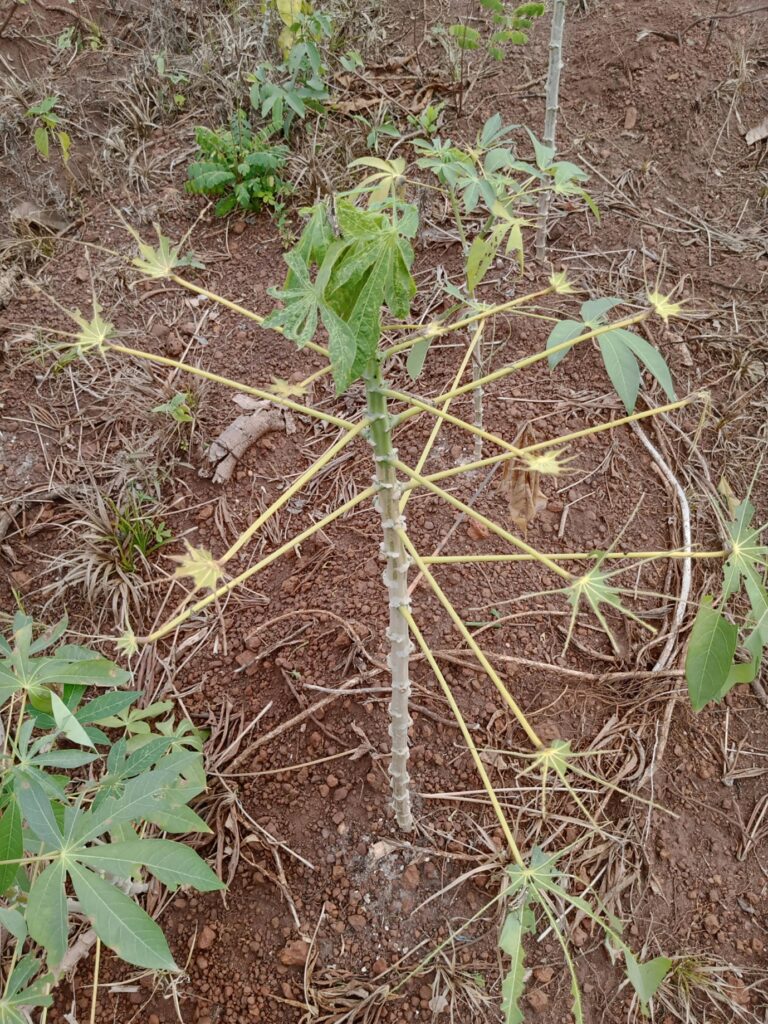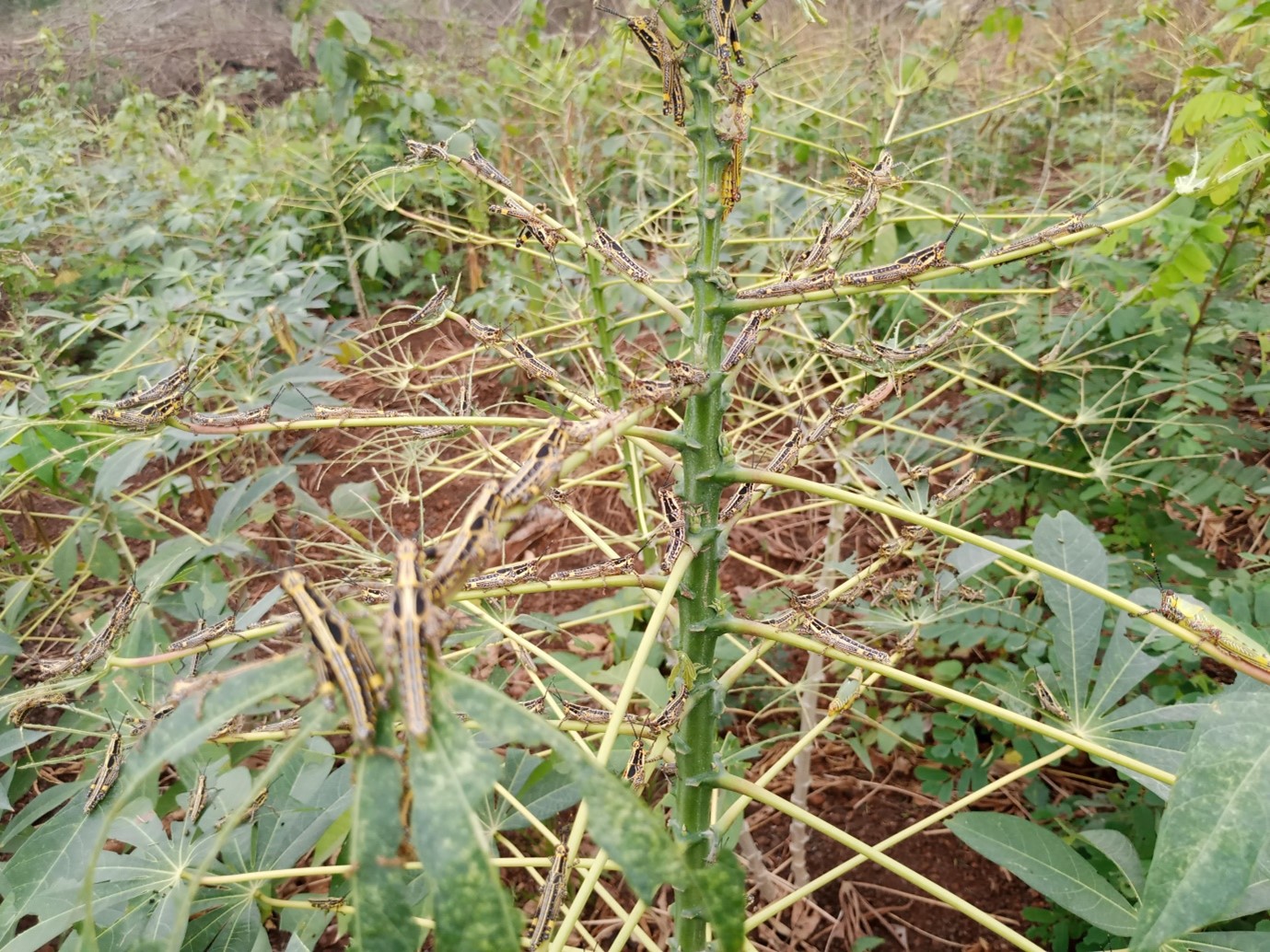Major Pests and Diseases of Cassava
Major Pests of Cassava
Cassava is a staple crop that is important for the food security of many African countries like Nigeria. The pests and diseases affecting cassava production are constantly increasing, putting crop production at risk [1, 2, 3]. Research has shown that cassava is one of the most cultivated crops in Africa, with an estimated 80 million hectares in over 34 countries [1, 2]. Nigeria leads in global cassava production compared to the entire cassava produced in Africa. For instance, Africa produced 157 million metric tonnes per annum out of the global 277 million, and Nigeria contributed to this with over 60 million metric tonnes annually[1, 2, 3,4]. Protecting cassava from diseases and pests is vital because of the enormous benefits this crop provides. These benefits can be direct and indirect. For instance, the direct benefits of cassava can be seen in food production and raw materials. Indirect benefits are employment to millions across the world. [1, 2, 3]
The two major diseases that threaten cassava crops in Nigeria are cassava mosaic disease (CMD) and cassava brown streak disease (CBSD). [4, 5, 6] These two diseases are deadly to cassava production. While cassava mosaic disease can lead to 40% to 70% yield losses, cassava brown streak disease can lead to complete yield losses of 90 to 100%. [1, 3, 7]
The following are common leaf and stem pests of cassava:
- cassava mealybug
- cassava green mite
- variegated grasshopper
- whiteflies [6, 7,8]
Cassava mealybug
The cassava mealybug, Phenacoccus manihoti, feeds on cassava plants, the leaves and the stems in particular. The cassava mealybug is commonly found at cassava shoot tips under the surfaces of leaves[8]. This pest injects a toxin into the leave of the cassava plant resulting in leaf withering, and the cassava’s growth becomes stunted. This can result in a considerable loss of crop yields of over 60%[1, 2]. There are two kinds of cassava mealy bugs. The green mealybug, Phenacoccus madeirensis, and the striped mealybug, Ferrisia virgate [1, 2, 3, 4, 5, 6, ]. While the green mealybug is more common on cassava than the striped mealybug, the striped mealybug occurs mostly on surfaces of cassava stems. The green mealybug and striped mealybug feed on cassava only and do not feed on other food crops. [1, 2]
Cassava green mite
The cassava green mite, Mononychellus progresivus Doreste, is one of the most destructive pests across the African continent, Nigeria in particular. It reduces cassava tuber yields by 14-80%. The crop suffers the highest mite damage in the arid-and –semi lands. This pest thrives in the wet season, and the level of the damage can be curtailed depending on other environmental factors. The cassava green mite affects cassava leaves and shoots tips [5, 6]. Cassava green mite pest affects young leaves, and red mite attacks older leaves. Red mites are not common and do not cause serious damage to cassava crops [7, 8]. Cassava green mite causes tiny yellow chlorotic spots on the upper leaf surfaces. The damage to cassava crops by cassava green mites is more severe in the dry than in the wet season.
Variegated grasshopper
The variegated grasshopper, Zonocerus variegatus, belongs to the same order (Orthoptera) as locusts. The Variegated grasshopper is the main grasshopper pest that attacks cassava. It is one of the important pests that cause yield loss in cassava produce. The variegated grasshopper feeds on cassava leaves and stems. This pest defoliates the stem, and damage is more common on older cassava crops than on younger cassava plants and is more severe in the dry than in the wet season. In addition to cassava, variegated grasshopper feeds on other plants also, such as vegetables, cashew, plantain, and many other crops [1,5,7].
Whiteflies
The whitefly, Bemisia tabaci, is one of the major agricultural pest groups that cause low productivity of cassava in Africa, Nigeria in particular. It belongs to cryptic species within the Bemisia tabaci sensu lato complex that causes significant harm to cassava in Nigeria. Whiteflies suck sap from the leaves. Whiteflies are responsible for transmitting plant viruses that can cause physical damage to cassava and a vector for disease. The pest injects the plant with viruses which cause cassava mosaic disease (CMD) and cassava brown streak disease (CBSD) [1, 2, 3].
Whiteflies are vectors for five broad categories of viruses:
- Begomovirus
- Ipomovirus
- Crinivirus
- Carlavirus
- Torradovirus [1, 2, 3]
Control strategies for cassava pest
- Early planting at the onset of rains.
- Carry out crop rotation.
- Biological control through using predatory mites and parasites.
- Integrated Pest Management is also highly advisable [1, 2, 3]

The most important Cassava Diseases
The two major cassava diseases common to cassava crops in Nigeria are cassava mosaic disease (CMD) and cassava brown streak disease (CMSD).
Cassava mosaic disease (CMD)
This disease ravaging cassava cultivation is caused by cassava mosaic begomoviruses (genus Begomovirus, family Geminiviridae) [1, 2, 3]. The whitefly is the vector that transmits the disease, which can be caused by using infected cassava cuttings as planting materials. Cassava mosaic disease (CMD) is a primary threat to cassava cultivation in Africa, Nigeria in particular. The disease is endemic and caused by vector whitefly. Cassava diseases are important concerns causing direct damage by feeding on the crop. This eventually led to yield reductions (cassava tubers). The disease causes a drastic reduction in cassava production from 20%-90% yield loss [1, 7, 8, 9]. Cassava plants affected by this disease in the early growth stage can be more severe and devastating than in the later stage of development. The disease manifests on the leaf leading to leaf reduction and leaf chlorosis. This could lead to a huge yield loss causing economic losses to the farmers. The following are enlisted as the symptoms of cassava mosaic disease:
Symptoms of cassava mosaic disease
- Yellowing and distortion of leaves.
- Stunted growth
- Misshapen and twisted leaflets
- Infected fruit appears mottled
- Dark green blisters.
- An overall reduction in the size of leaves and plants [1, 2, 3, 4,5]
Cassava Brown Streak Disease:
Unlike cassava mosaic disease (CMD), cassava brown streak disease (CBSD) is caused by two distinct species of ipomoviruses. These are the cassava brown streak virus and the Ugandan cassava brown streak virus. Both species belong to the family Potyviridae. Cassava brown streak disease (CBSD) is a severe threat to food security and is a viral disease ravaging cassava cultivation [1, 2, 3]. The cassava brown streak disease (CBSD) is less widespread and has received less attention than CMD [1, 2, 3]. The disease causes significant losses due to root necrosis. Whiteflies are a vector for CBSD. This disease manifests on stems, thereby causing dry hard rot in roots. This affects the quality and quantity of the cassava produced [1, 2, 3, 4].
Control strategies and prevention for cassava disease
- Field hygiene is one of the major preventive mechanisms in preventing cassava diseases. It involves uprooting and destroying all cassava plants manifesting the disease symptoms. By so doing, it reduces the source of the disease.
- Planting disease-free (healthy-certified) cuttings are the most effective for minimizing the spread of the disease. That is using cuttings plant materials that are healthy and virus free on a healthy plot.
- Remove all infected plants and destroy them.
- The vector can aid the transport of the disease when cassava plants are close to infected fields [1, 2, 3, 4,5]
References
- https://naads.or.ug/cassava-pests-and-disease-control/
- https://plantvillage.psu.edu/topics/cassava-pests-and-diseases_-save-and-grow/infos
- https://guardian.ng/features/no-cassava-brown-streak-diseases-detected-in-nigeria-west-africa-report/
- IITA (2010). Cassava Disease Surveillance Surveys. Mapping Report. Great Lakes Cassava Initiative. Nigeria: International Institute of Tropical Agriculture.
- IITA (2014). IITA Bulletin, Issue 2215. Nigeria: International Institute of Tropical Agriculture. http://www.iita.org/c/document_library/get_ file?p_l_id=3299855&folderId=4274004&name=DLFE-7712.pdf.
- Legg, J. P., Jeremiah, S. C., Obiero, H. M., Maruthi, M. N., Ndyetabula, I., Okao-Okuja, G., Bouwmeester, H., Bigirimana, S., Tata-Hangy, W. & other authors (2011). Comparing the regional epidemiology of the cassava mosaic and cassava brown streak virus pandemics in Africa Virus Res 159, 161–170
- Pariyo, A., Tukamuhabwa, P., Baguma, Y., Kawuki, R. S., Alicai, T.,Gibson, P., Kanju, E., Wanjala, B. W., Harvey, J. & other authors (2013). Simple sequence repeats (SSR) diversity of cassava in South, East and Central Africa in relation to resistance to cassava brown streak disease. Afr J Biotechnol 12, 4453–4464.
- Patil, B. L. & Fauquet, C. M. (2009). Cassava mosaic geminiviruses: actual knowledge and perspectives. Mol Plant Pathol 10, 685–701.
- Patil, B. L. & Fauquet, C. M. (2014). Light intensity and temperature affect systemic spread of silencing signal in transient agroinfiltration studies. Mol Plant Pathol n/a
- Cassava: History, Nutritional Value, and Plant Information
- Cassava Climate and Soil Requirements
- Cassava Varieties
- Cassava Propagation and Planting
- Cassavas Weed Management and Control
- Cassava crop Water Needs and irrigation Systems
- Cassava Fertilization Requirements
- Pruning of Cassava plants
- Major Pests and Diseases of Cassava
- Cassava Harvest, Yield per hectare and Storage









































































